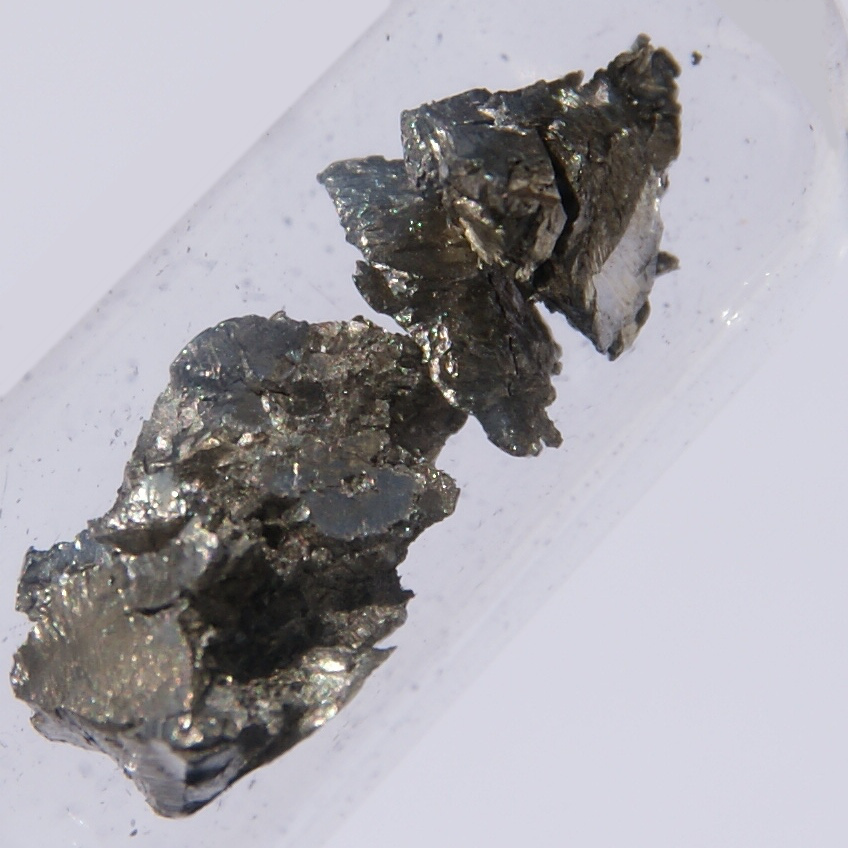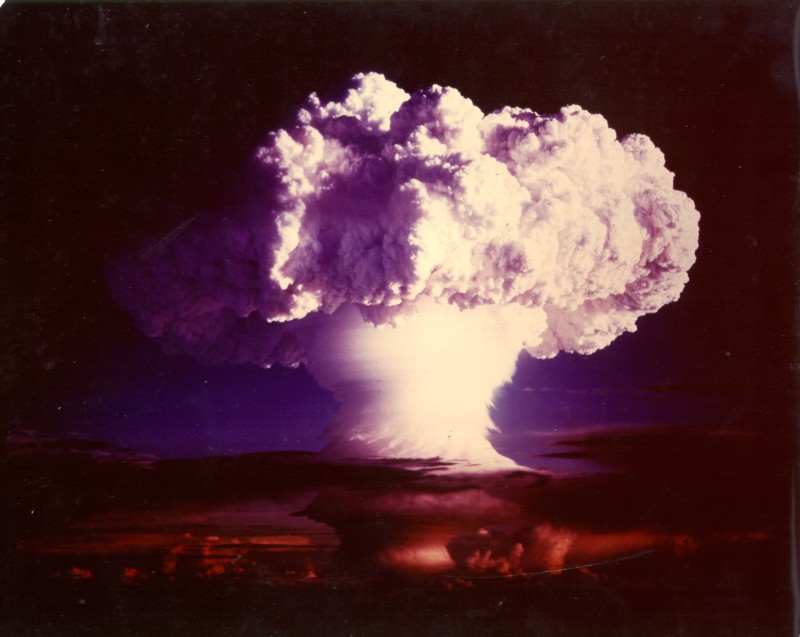|
Holmium
Holmium is a chemical element with the symbol Ho and atomic number 67. It is a rare-earth element and the eleventh member of the lanthanide series. It is a relatively soft, silvery, fairly corrosion-resistant and malleable metal. Like a lot of other lanthanides, holmium is too reactive to be found in native form, as pure holmium slowly forms a yellowish oxide coating when exposed to air. When isolated, holmium is relatively stable in dry air at room temperature. However, it reacts with water and corrodes readily, and also burns in air when heated. In nature, holmium occurs together with the other rare-earth metals (like thulium). It is a relatively rare lanthanide, making up 1.4 parts per million of the Earth's crust, an abundance similar to tungsten. Holmium was discovered through isolation by Swedish chemist Per Theodor Cleve and independently by Jacques-Louis Soret and Marc Delafontaine, who observed it spectroscopically in 1878. Its oxide was first isolated from rare-earth ores ... [...More Info...] [...Related Items...] OR: [Wikipedia] [Google] [Baidu] |
Holmium(III) Oxide
Holmium(III) oxide, or holmium oxide is a chemical compound of a rare-earth element holmium and oxygen with the formula Ho2O3. Together with dysprosium(III) oxide (Dy2O3), holmium oxide is one of the most powerfully paramagnetic substances known. The oxide, also called holmia, occurs as a component of the related erbium oxide mineral called erbia. Typically, the oxides of the trivalent lanthanides coexist in nature, and separation of these components requires specialized methods. Holmium oxide is used in making specialty colored glasses. Glass containing holmium oxide and holmium oxide solutions have a series of sharp optical absorption peaks in the visible spectral range. They are therefore traditionally used as a convenient calibration standard for optical spectrophotometers. Properties Appearance Holmium oxide has some fairly dramatic color changes depending on the lighting conditions. In daylight, it is a tannish yellow color. Under trichromatic light, it is a fiery orange re ... [...More Info...] [...Related Items...] OR: [Wikipedia] [Google] [Baidu] |
Lanthanide Series
The lanthanide () or lanthanoid () series of chemical elements comprises the 15 metallic chemical elements with atomic numbers 57–71, from lanthanum through lutetium. These elements, along with the chemically similar elements scandium and yttrium, are often collectively known as the rare-earth elements or rare-earth metals. The informal chemical symbol Ln is used in general discussions of lanthanide chemistry to refer to any lanthanide. All but one of the lanthanides are f-block elements, corresponding to the filling of the 4f electron shell. There is some dispute on whether lanthanum or lutetium is a d-block element, but lutetium is usually considered so by those who study the matter; it is included due to its chemical similarities with the other 14. All lanthanide elements form trivalent cations, Ln3+, whose chemistry is largely determined by the ionic radius, which decreases steadily from lanthanum to lutetium. These elements are called lanthanides because the elements in ... [...More Info...] [...Related Items...] OR: [Wikipedia] [Google] [Baidu] |
Lanthanide
The lanthanide () or lanthanoid () series of chemical elements comprises the 15 metallic chemical elements with atomic numbers 57–71, from lanthanum through lutetium. These elements, along with the chemically similar elements scandium and yttrium, are often collectively known as the rare-earth elements or rare-earth metals. The informal chemical symbol Ln is used in general discussions of lanthanide chemistry to refer to any lanthanide. All but one of the lanthanides are f-block elements, corresponding to the filling of the 4f electron shell. There is some dispute on whether lanthanum or lutetium is a d-block element, but lutetium is usually considered so by those who study the matter; it is included due to its chemical similarities with the other 14. All lanthanide elements form trivalent cations, Ln3+, whose chemistry is largely determined by the ionic radius, which decreases steadily from lanthanum to lutetium. These elements are called lanthanides because the elements i ... [...More Info...] [...Related Items...] OR: [Wikipedia] [Google] [Baidu] |
Lanthanides
The lanthanide () or lanthanoid () series of chemical elements comprises the 15 metallic chemical elements with atomic numbers 57–71, from lanthanum through lutetium. These elements, along with the chemically similar elements scandium and yttrium, are often collectively known as the rare-earth elements or rare-earth metals. The informal chemical symbol Ln is used in general discussions of lanthanide chemistry to refer to any lanthanide. All but one of the lanthanides are f-block elements, corresponding to the filling of the 4f electron shell. There is some dispute on whether lanthanum or lutetium is a d-block element, but lutetium is usually considered so by those who study the matter; it is included due to its chemical similarities with the other 14. All lanthanide elements form trivalent cations, Ln3+, whose chemistry is largely determined by the ionic radius, which decreases steadily from lanthanum to lutetium. These elements are called lanthanides because the elements in ... [...More Info...] [...Related Items...] OR: [Wikipedia] [Google] [Baidu] |
Per Theodor Cleve
Per Teodor Cleve (10 February 1840 – 18 June 1905) was a Swedish chemist, biologist, mineralogist and oceanographer. He is best known for his discovery of the chemical elements holmium and thulium. Born in Stockholm in 1840, Cleve earned his BSc and PhD from Uppsala University in 1863 and 1868, respectively. After receiving his PhD, he became an assistant professor of chemistry at the university. He later became professor of general and agricultural chemistry. In 1874 he theorised that didymium was in fact two elements; this theory was confirmed in 1885 when Carl Auer von Welsbach discovered neodymium and praseodymium. In 1879 Cleve discovered holmium and thulium. His other contributions to chemistry include the discovery of aminonaphthalenesulfonic acids, also known as Cleve's acids. From 1890 on he focused on biological studies. He developed a method of determining the age and order of late glacial and postglacial deposits from the types of diatom fossils in the deposits, and ... [...More Info...] [...Related Items...] OR: [Wikipedia] [Google] [Baidu] |
Thulium
Thulium is a chemical element with the symbol Tm and atomic number 69. It is the thirteenth and third-last element in the lanthanide series. Like the other lanthanides, the most common oxidation state is +3, seen in its oxide, halides and other compounds; however, the +2 oxidation state can also be stable. In aqueous solution, like compounds of other late lanthanides, soluble thulium compounds form coordination complexes with nine water molecules. In 1879, the Swedish chemist Per Teodor Cleve separated from the rare earth oxide erbia another two previously unknown components, which he called holmia and thulia; these were the oxides of holmium and thulium, respectively. A relatively pure sample of thulium metal was first obtained in 1911. Thulium is the second-least abundant of the lanthanides, after radioactively unstable promethium which is only found in trace quantities on Earth. It is an easily workable metal with a bright silvery-gray luster. It is fairly soft and slowly ... [...More Info...] [...Related Items...] OR: [Wikipedia] [Google] [Baidu] |
Dysprosium
Dysprosium is the chemical element with the symbol Dy and atomic number 66. It is a rare-earth element in the lanthanide series with a metallic silver luster. Dysprosium is never found in nature as a free element, though, like other lanthanides, it is found in various minerals, such as xenotime. Naturally occurring dysprosium is composed of seven isotopes, the most abundant of which is 164Dy. Dysprosium was first identified in 1886 by Paul Émile Lecoq de Boisbaudran, but it was not isolated in pure form until the development of ion-exchange techniques in the 1950s. Dysprosium has relatively few applications where it cannot be replaced by other chemical elements. It is used for its high thermal neutron absorption cross-section in making control rods in nuclear reactors, for its high magnetic susceptibility () in data-storage applications, and as a component of Terfenol-D (a magnetostrictive material). Soluble dysprosium salts are mildly toxic, while the insoluble salts are consid ... [...More Info...] [...Related Items...] OR: [Wikipedia] [Google] [Baidu] |
Einsteinium
Einsteinium is a synthetic element with the symbol Es and atomic number 99. Einsteinium is a member of the actinide series and it is the seventh transuranium element. It was named in honor of Albert Einstein. Einsteinium was discovered as a component of the debris of the first hydrogen bomb explosion in 1952. Its most common isotope, einsteinium-253 (half-life 20.47 days), is produced artificially from decay of californium-253 in a few dedicated high-power nuclear reactors with a total yield on the order of one milligram per year. The reactor synthesis is followed by a complex process of separating einsteinium-253 from other actinides and products of their decay. Other isotopes are synthesized in various laboratories, but in much smaller amounts, by bombarding heavy actinide elements with light ions. Owing to the small amounts of produced einsteinium and the short half-life of its most easily produced isotope, there are currently almost no practical applications for it outside bas ... [...More Info...] [...Related Items...] OR: [Wikipedia] [Google] [Baidu] |
Erbium
Erbium is a chemical element with the symbol Er and atomic number 68. A silvery-white solid metal when artificially isolated, natural erbium is always found in chemical combination with other elements. It is a lanthanide, a rare-earth element The rare-earth elements (REE), also called the rare-earth metals or (in context) rare-earth oxides or sometimes the lanthanides (yttrium and scandium are usually included as rare earths), are a set of 17 nearly-indistinguishable lustrous silve ..., originally found in the gadolinite mine in Ytterby, Sweden, which is the source of the element's name. Erbium's principal uses involve its pink-colored Er3+ ions, which have optical fluorescent properties particularly useful in certain laser applications. Erbium-doped glasses or crystals can be used as optical amplification media, where Er3+ ions are optically pumped at around 980 or and then radiate light at in stimulated emission. This process results in an unusually mechanically simple la ... [...More Info...] [...Related Items...] OR: [Wikipedia] [Google] [Baidu] |
Marc Delafontaine
Marc Delafontaine (March 31, 1837/1838, Céligny, Switzerland–1911) was a Swiss chemist and spectroscopist who was involved in discovering and investigating some of the rare earth elements. Career Delafontaine studied with Jean Charles Galissard de Marignac at the University of Geneva. He also worked at the University of Geneva. Delafontaine moved to the United States of America, arriving in New York in 1870, and later becoming a naturalized citizen. He taught in Chicago, Illinois at city high schools, and at a women's college. He also worked as analytical chemist with the Chicago Police Department. Research Holmium In 1878, along with Jacques-Louis Soret, Delafontaine first observed holmium spectroscopically. In 1879, Per Teodor Cleve chemically separated it from thulium and erbium. All three men are given credit for the element's discovery. Yttrium, terbium and erbium In 1843 Carl Gustaf Mosander discovered terbium and erbium Erbium is a chemical element with the s ... [...More Info...] [...Related Items...] OR: [Wikipedia] [Google] [Baidu] |
Rare-earth Element
The rare-earth elements (REE), also called the rare-earth metals or (in context) rare-earth oxides or sometimes the lanthanides (yttrium and scandium are usually included as rare earths), are a set of 17 nearly-indistinguishable lustrous silvery-white soft heavy metals. Compounds containing rare earths have diverse applications in electrical and electronic components, lasers, glass, magnetic materials, and industrial processes. Scandium and yttrium are considered rare-earth elements because they tend to occur in the same ore deposits as the lanthanides and exhibit similar chemical properties, but have different electronic and magnetic properties. These metals tarnish slowly in air at room temperature and react slowly with cold water to form hydroxides, liberating hydrogen. They react with steam to form oxides, and at elevated temperature (400°C) ignite spontaneously. These elements and their compounds have no biological function other than in several specialized enzymes, s ... [...More Info...] [...Related Items...] OR: [Wikipedia] [Google] [Baidu] |
Jacques-Louis Soret
Jacques-Louis Soret (30 June 1827 – 13 May 1890) was a Swiss chemist and spectroscopist. He studied both spectroscopy and electrolysis. He held the chairs of chemistry (1873-1887) and medical physics (1887-1890) at the University of Geneva. Soret determined the chemical composition and density of ozone and the conditions for its production. He described it correctly as being composed of three oxygen atoms bound together. Soret also developed optical instruments. He climbed Mont Blanc, where he was the first scientist to make actinometric measurements of solar radiation. These observations were published in the ''Philosophical Magazine'' in 1867. In 1878, he and Marc Delafontaine were the first to spectroscopically observe the element later named holmium, which they identified simply as an "earth X" derived from "erbia". Independently, Per Teodor Cleve separated it chemically from thulium and erbium in 1879. All three researchers are given credit for the element's dis ... [...More Info...] [...Related Items...] OR: [Wikipedia] [Google] [Baidu] |









